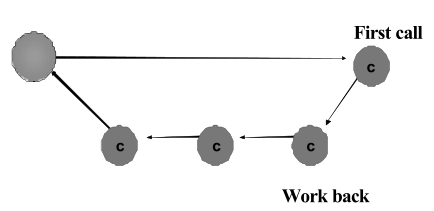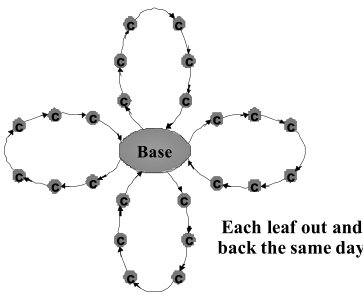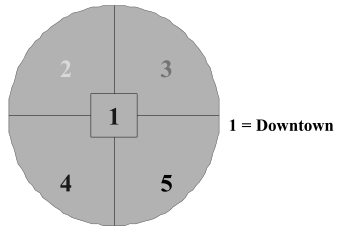Routing and scheduling plans aim to maintain the lines of communication, to optimize sales coverage and minimize wasted time. When management is in- formed at all times of salespersons’ whereabouts in the field-or at least knows where they should be-it is easy to contact them to provide needed information or last-minute instructions. Chances are good that sales personnel will be where they are supposed to be.
Routing and scheduling plans improve sales coverage. The mechanics of setting up a routing plan are simple, but in working out the plan, detailed information is required on the numbers and locations of customers, the means and methods of transportation connecting customer concentrations, and desired call frequency rates. Detailed maps are needed showing not only towns and cities and transportation routes but trading-area boundaries, mountain ranges, lakes, bridges, and ferry lines. If sales personnel are to travel by air, airport locations need spotting. The route, or routes, finally laid out should permit the salesperson to return home at least on weekends.
If the route planner considers the desired call frequency rate for each customer on the route, the call schedule is a by-product of setting up the route. In most cases, however, making up the call schedule is more than planning the route. Customers and prospects are segregated according to the desired call frequency” rate using detailed maps, the planner identifies the locations of members of each customer and prospect group and reconciles the route with these locations. Hence, often the salesperson has a different route each time he or she travels the territory, to achieve the desired call frequencies and to incorporate new customers and prospects into the itinerary. Furthermore, because changes occur in account classifications, prospects, competitive activity, as well as in road conditions, it is impractical to set up fixed route and call schedules good for long periods.
Routing and scheduling plans reduce wasted time by sales personnel. Much backtracking, travel time and other “no selling” time is eliminated, and scheduled call frequency is to fit customers’ needs. Effective routing and scheduling automatically builds up the size of the average order.
In scheduling sales personnel, some firms not only designate the customers to call upon each day but prescribe the time of day to make each call. Detailed scheduling is coupled with a system for making advance appointments. Companies not using scheduling plans usually suggest advance appointments, but often salespeople ignore this suggestion. For effective detailed scheduling the scheduler needs current information on time required for each call, probable waiting time at each stop, travel time between calls, and the probable time with each customer. This information is difficult to collect and update. Detailed scheduling is most feasible when customers give their full cooperation. Most firms allow their sales personnel “time cushions” to allow for the many variations met on each selling trip.
Companies, almost without exception, benefit from systematic routing and scheduling, but not all find detailed scheduling feasible. The petroleum marketing companies, and other firms with combination driver-salespersons, use detailed routing and scheduling plans successfully, as do several large pharmaceutical manufacturers. Less detailed routing and scheduling plans are used by wholesalers of groceries, drugs, and hardware. Detailed scheduling plans are appropriate in trades typified by frequent calls, great homogeneity among customers, short travel time between calls, and highly standardized products not requiring large amounts of creative selling time-that is, in situations where trade selling predominates.
The size of the territory and geographic layout determine the type of the route. Sales personnel should lay out a travel route so that they can start from their home in the morning and return in the evening. Remember critical factor is time and not miles. In some cases using major nonstop highways may increase miles but total travel time may decrease. The actual route the salespeople follow each day within each section can help maximize their use of daily prime selling hours. They should make long drives usually in the morning and in late afternoon, if possible. For example if most of their accounts are strung out more or less in a straight line from their home base they should get up early and drive to the far end of the territory before making the first call. They would then work their way back, so they end up near home at the end of the day.
Straight-Line Pattern

Cloverleaf Pattern

Major City Pattern

The routing patterns shown above helps sales personnel economies time. In clover leaf pattern the sale personnel is placed in the middle and start in the morning and tries to cover maximum number of accounts in a day in the fashion shown in the figure. In major city patter also the sales personnel should cover one area at a time since it represents the different industrial areas.
Routing, scheduling, and control: The routing plan, the scheduling plan, or both assist sales management in obtaining closer control over sales personnel’s movements and time expenditures. The routing and scheduling plans are integral parts of the overall process of establishing sales territories and assigning sales personnel. Any routing or scheduling plan should have frequent checkups to detect needed adjustments. Call reports are compared with route and call schedules to determine whether plans are followed. Variations or discrepancies are noted and sales personnel asked for explanations. Adherence to the plans is also enforced through frequent and unannounced visits to the field by supervisors or branch sales managers.

